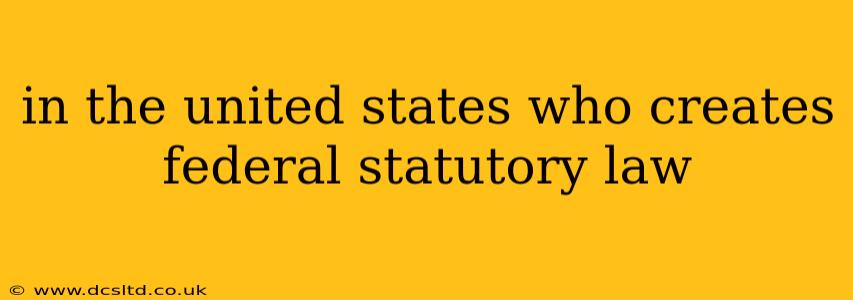The creation of federal statutory law in the United States is a complex process involving multiple branches of government, checks and balances, and a delicate dance between legislative intent and constitutional constraints. Understanding this process is crucial to comprehending the foundation of American law. Ultimately, the United States Congress—comprising the Senate and the House of Representatives—holds the primary power to create federal statutory law.
How a Bill Becomes a Law: A Step-by-Step Guide
The journey of a bill to becoming a federal law is often lengthy and intricate. Here's a breakdown of the key stages:
-
Bill Introduction: A proposed law, or bill, can be introduced in either the House of Representatives or the Senate by a member of Congress. This member is known as the bill's sponsor.
-
Committee Consideration: The bill is then referred to a relevant committee based on its subject matter. Committees hold hearings, solicit expert testimony, and often amend the bill before sending it to the full chamber for consideration. This is a crucial stage where much of the shaping of legislation occurs.
-
Floor Debate and Vote: Once a committee approves a bill, it goes to the full House or Senate for debate and a vote. This process involves various procedures, such as amendments, filibusters (in the Senate), and procedural votes to advance the bill. If the bill passes in one chamber, it moves to the other.
-
Conference Committee (If Necessary): If the House and Senate pass different versions of the same bill, a conference committee comprised of members from both chambers is formed to reconcile the differences. The resulting compromise bill is then sent back to both chambers for a final vote.
-
Presidential Action: Once both chambers approve the final version of the bill, it is sent to the President. The President can either sign the bill into law, veto it (rejecting it), or take no action. If the President vetoes the bill, Congress can override the veto with a two-thirds vote in both chambers, making the bill law despite the President's objection. If the President takes no action within 10 days (excluding Sundays) while Congress is in session, the bill automatically becomes law.
What Roles Do Other Branches Play?
While Congress is the primary lawmaking body, other branches of government play significant roles:
-
The Executive Branch (President): The President has the power to veto legislation, significantly influencing the final form of laws. The President also plays a role in enforcing laws through executive orders and agency regulations.
-
The Judicial Branch (Supreme Court and Federal Courts): The courts interpret laws and determine their constitutionality. Judicial review allows the courts to strike down laws deemed unconstitutional, effectively nullifying them.
Who Influences the Creation of Federal Statutory Law?
Beyond the formal process, various groups and individuals influence the creation of federal statutory law. These include:
- Lobbyists: Representatives of interest groups who seek to influence legislators to support or oppose specific bills.
- Constituents: Citizens who contact their representatives to express their views on proposed legislation.
- Think Tanks and Research Organizations: These organizations conduct research and provide information that can inform legislative decisions.
What are the limitations on Congress's lawmaking power?
Congress's power to make federal statutory law is not unlimited. The Constitution imposes several limitations, including:
- Enumerated Powers: Congress can only legislate on matters specifically granted to it by the Constitution.
- Separation of Powers: The powers of Congress are balanced by the powers of the Executive and Judicial branches.
- Checks and Balances: The system of checks and balances ensures that no single branch becomes too powerful.
- Judicial Review: The Supreme Court can review and overturn laws deemed unconstitutional.
Understanding the process of creating federal statutory law requires understanding the intricate interplay of these branches, their powers, and the numerous influences shaping the legislative landscape. It's a dynamic and continuously evolving process.
